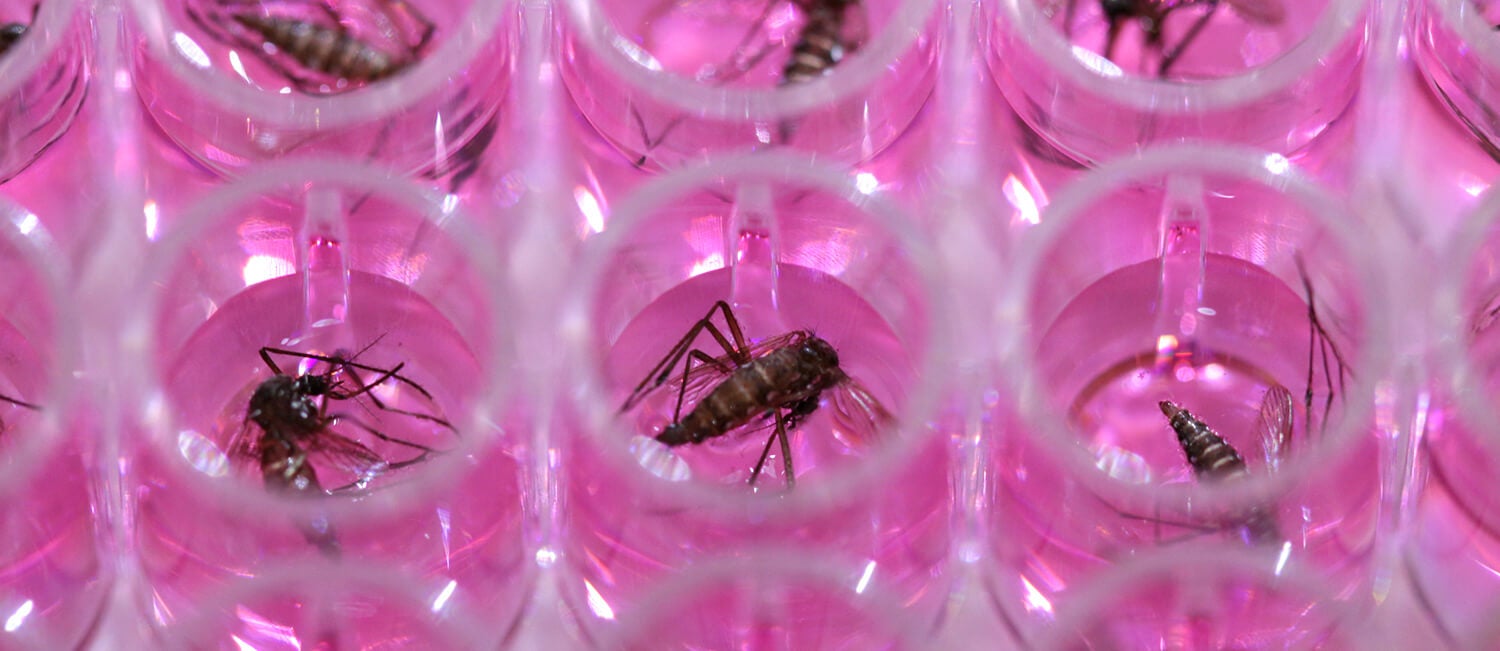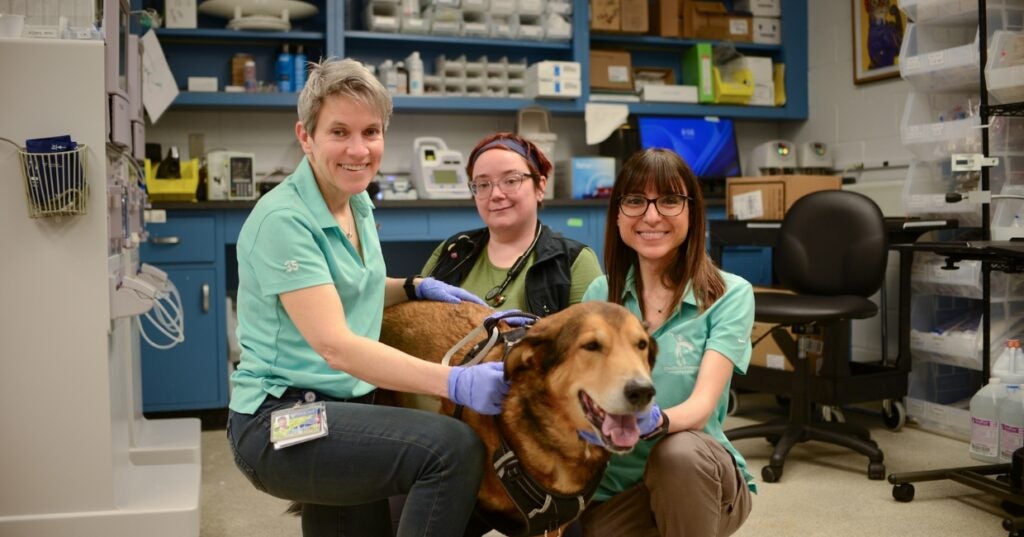Stopping Disease Transmission at the Source

Faculty In This Story
Some of the world’s most concerning infectious diseases, from malaria and Chagas disease to heartworm and leishmaniasis, are transmitted by mosquitoes and other insect vectors. While an ample body of research has worked to develop treatments and preventive strategies that focus on what happens once a pathogen has entered the body of a human or animal, Penn Vet’s Michael Povelones, PhD, assistant professor of Pathobiology, takes a different approach, jumping back a step to consider how the chain of disease transmission could be halted before a pathogen ever leaves the insect vector.
In recent work, Povelones and colleagues have made advancements toward this goal, working in several different infection models. A paper out last year in the journal Proceedings of the National Academy of Sciences reported the successful outcome of the lab’s effort to ramp up the immune response of mosquitoes in order to prevent them from transmitting the related parasitic worms Dirofilaria immitis, which causes the debilitating canine heartworm disease, and Brugia malayi, responsible for lymphatic filariasis, also known as elephantiasis.
Studying a strain of Aedes aegypti mosquito that is resistant to infection with the heartworm parasite, the team — including co-first authors Elizabeth Edgerton, now a VMD student in the class of 2022, and research technician Abigail McCrea — discovered that this quality correlates with a hypercharged immune response. By activating this immune system defense in otherwise-susceptible mosquitoes, they were able to stop parasites — both D. immitis and B. malayi — from developing into a transmissible form in the insects. Such a blockade could stop filarial parasites from passing to dogs or humans.
“Heartworm is everywhere; in some places if you don’t give dogs a preventive drug they’re almost definitely going to get heartworm,” Povelones says. “On top of that there is emerging drug-resistant heartworm parasites in certain areas. All of that makes the mosquito seem like an attractive target to make inroads into these problems and prevent disease transmission.” The lab has recently had a grant recommended for funding by the Morris Animal Foundation to explore this concept further.
Although the parasite that causes lymphatic filariasis behaves slightly differently within the mosquito than the heartworm parasite, Povelones was encouraged that the same immune system activation strategy significantly lowered mosquitoes’ ability to pass along either parasite.
“People are starting to look at these solutions that focus on the mosquito in diseases like malaria and dengue,” he said. “I don’t think it’s disingenuous to say that these kinds of approaches could be used, perhaps in a locally targeted way, to stop heartworm or lymphatic filariasis.”
In a parallel vein of work, Povelones has teamed up with his wife, Megan Povelones, PhD, a faculty member at Villanova University, to investigate another group of disease-causing microorganisms called kinetoplastids. These single-celled microbes are responsible for serious infections such as Chagas disease, African sleeping sickness, and leishmaniasis. The collaboration led to a new model for studying how these parasites latch on to mosquitoes’ insides, a necessary step in propagating infection to other organisms. They described the model, which uses the non-disease-causing kinetoplastid species Crithidia fasciculata, in a 2019 paper in PLOS Neglected Tropical Diseases.
“The parasite has to hold on so it won’t pass right through,” said Povelones. “It needs to get retained in the gut in order to multiply and eventually get transmitted. These mechanisms of adherence seem to be [shared] across kinetoplastid species, so the hope is that our insights about Crithidia will tell us something about adherence in the medically relevant species.”
The couple recently received a grant from the National Institutes of Health to continue enlisting the model system to understand what prompts the shift from a “swimming” form to an adherent form. If a chemical or genetic manipulation could prevent the parasite from adhering, then perhaps the parasites would pass through the vectors, unable to be transmitted to a human or other animal.
And in yet another innovative model system developed by the lab, Penn Vet VMD-PhD student Greg Sousa led the lab’s efforts, with the readout coming from an unlikely source: mosquito poop.
“Greg found out in the course of doing standard assays that if we inject mosquitoes with bacteria, they start to secrete a pigment in their waste,” Povelones said of the study, shared in the journal PLOS Pathogens. “Basically, their poop is extra brown. And so now we can go in and challenge them with an infection or knock down a gene of interest and learn something about what is happening with their immune defenses by these spots they leave.”
The new model, which can be applied quickly and simply using just a few mosquitoes, has already been taken up by other mosquito researchers. For the Povelones lab, it has enabled them to begin identifying components of the immune system that mosquitoes use to mount a response against the malaria parasite, among other infections.
As the new Institute for Infectious and Zoonotic Diseases gains momentum, Povelones is eager to continue contributing to the University’s coordinated efforts to illuminate and solve challenges when it comes to animal and human health. “Many of these neglected diseases we study — whether it’s trypanosomes, malaria, or leishmaniasis — affect dogs and other animals as well,” Povelones said. “There are zoonotic threads throughout this work.”
Related News

Wild birds are driving the current U.S. bird flu outbreak (link is external)
Since late 2021, a panzootic, or “a pandemic in animals,” of highly pathogenic bird flu variant H5N1 has devastated wild birds, agriculture, and mammals.

Penn Vet’s Annual Research Retreat Calls for the Power of Synergy in Challenging Times
Noting the challenges ahead, but celebrating the many breakthroughs at hand, the University of Pennsylvania School of Veterinary Medicine (Penn Vet) community gathered for their 31st annual Research Retreat held…

Dogs with cancer are helping save lives—both canine and human (link is external)
The Comparative Immunotherapy Program led by Penn Vet’s Nicola Mason is redefining how therapies are developed and tested—uniting human and veterinary medicine to move promising immunotherapies forward.
About Penn Vet
Ranked among the top ten veterinary schools worldwide, the University of Pennsylvania School of Veterinary Medicine (Penn Vet) is a global leader in veterinary education, research, and clinical care. Founded in 1884, Penn Vet is the first veterinary school developed in association with a medical school. The school is a proud member of the One Health initiative, linking human, animal, and environmental health.
Penn Vet serves a diverse population of animals at its two campuses, which include extensive diagnostic and research laboratories. Ryan Hospital in Philadelphia provides care for dogs, cats, and other domestic/companion animals, handling more than 30,000 patient visits a year. New Bolton Center, Penn Vet’s large-animal hospital on nearly 700 acres in rural Kennett Square, PA, cares for horses and livestock/farm animals. The hospital handles more than 6,300 patient visits a year, while our Field Services have gone out on more than 5,500 farm service calls, treating some 22,400 patients at local farms. In addition, New Bolton Center’s campus includes a swine center, working dairy, and poultry unit that provide valuable research for the agriculture industry.
